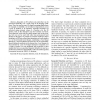Free Online Productivity Tools
i2Speak
i2Symbol
i2OCR
iTex2Img
iWeb2Print
iWeb2Shot
i2Type
iPdf2Split
iPdf2Merge
i2Bopomofo
i2Arabic
i2Style
i2Image
i2PDF
iLatex2Rtf
Sci2ools
3DIM
2011
IEEE
2011
IEEE
Automatic Keypoint Detection on 3D Faces Using a Dictionary of Local Shapes
—Keypoints on 3D surfaces are points that can be extracted repeatably over a wide range of 3D imaging conditions. They are used in many 3D shape processing applications; for example, to establish a set of initial correspondences across a pair of surfaces to be matched. Typically, keypoints are extracted using extremal values of a function over the 3D surface, such as the descriptor map for Gaussian curvature. That approach works well for salient points, such as the nosetip, but can not be used with other less pronounced local shapes. In this paper, we present an automatic method to detect keypoints on 3D faces, where these keypoints are locally similar to a set of previously learnt shapes, constituting a ‘local shape dictionary’. The local shapes are learnt at a set of 14 manuallyplaced landmark positions on the human face. Local shapes are characterised by a set of 10 shape descriptors computed over a range of scales. For each landmark, the proportion of face meshes that have an...
| Added | 12 Dec 2011 |
| Updated | 12 Dec 2011 |
| Type | Journal |
| Year | 2011 |
| Where | 3DIM |
| Authors | Clement Creusot, Nick Pears, Jim Austin |
Comments (0)

